When you’re ready to rock, nothing is more frustrating than discovering that your solid state guitar amp won’t turn on. The lack of power not only hinders your ability to play but also leaves you wondering about the cause of the issue. In this article, we will explore common causes of a solid state guitar amp not turning on and provide practical troubleshooting steps to help you get your amp up and running again.
- Power Supply:
a. Power Outlet: Ensure that the power outlet you are using is functioning properly. Try plugging another device into the same outlet to verify if it is receiving power. If the outlet is dead, check the circuit breaker or try a different outlet.
b. Power Cable: Examine the power cable for any signs of damage, such as cuts or frayed ends. If the cable is damaged, replace it with a new one that matches the required specifications of your amplifier.
c. Fuse: Check if your amplifier has a fuse and verify its condition. If the fuse is blown, replace it with a new one of the same rating. However, if the fuse blows again immediately after replacement, there may be an underlying issue that requires professional attention.
- On/Off Switch and Controls:
a. On/Off Switch: Ensure that the on/off switch is in the correct position. Sometimes, it can be easy to overlook this simple step.
b. Control Settings: Certain amplifier models may have built-in safety features that prevent them from turning on if certain controls, such as the master volume or presence, are set to extreme levels. Reset these controls to a moderate setting and attempt to turn on the amp.
- Internal Issues:
a. Overheating Protection: Some amplifiers have built-in protection circuits that prevent them from turning on if they detect excessive heat. Allow the amplifier to cool down for an extended period and try turning it on again. Ensure that the amplifier has adequate ventilation to prevent overheating in the future.
b. Loose Connections: Inspect the internal connections, such as cables, wires, and connectors, for any signs of looseness or disconnection. Reconnect any loose connections securely. If you are uncomfortable working with internal components, seek assistance from a qualified technician.
c. Internal Fuse or Circuit Breaker: Check if your amplifier has an internal fuse or circuit breaker that may have tripped. Refer to the amplifier’s manual to locate and address any internal fuse issues. If the problem persists, professional assistance may be required.
- External Factors:
a. External Switching Devices: If your amplifier is equipped with external switching devices, such as footswitches or effects loop switches, ensure that they are properly connected and functioning. Faulty or incompatible switching devices can prevent the amplifier from turning on.
b. Remote Control or MIDI Settings: For amplifiers with remote control or MIDI capabilities, verify that the settings are configured correctly. Incorrect settings can lead to power issues.
Conclusion:
A solid state guitar amp that won’t turn on can be frustrating, but by troubleshooting the power supply, checking the on/off switch and controls, addressing internal issues, and considering external factors, you can effectively diagnose and resolve the problem. Remember to exercise caution when working with electronic equipment, and if necessary, consult a qualified technician for assistance. With diligent troubleshooting, you’ll soon have your amp powering up and ready to unleash your musical prowess.


